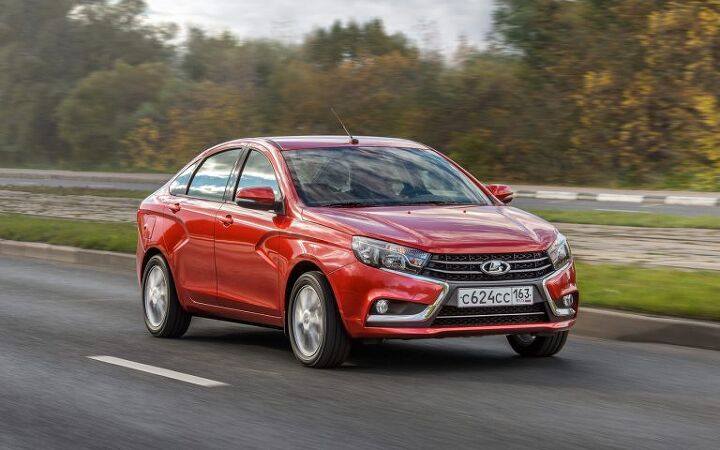Here's What an Ex-Volvo Designer Did For Poor Old Lada

Times are still tough in Russia, and your average Moscovite or St. Petersburgian doesn’t want to risk buying a new car — unless it’s a vivid, modern new Lada.
Lada, the much-maligned butt of Western jokes for decades, has reaped the rewards of luring a British ex-Volvo designer into its fold. In a vehicle market that continues to contract like a dying star, Lada’s new models are a pinpoint of light.
Steve Mattin holds an impressive resumé. Before joining AvtoVAZ’s Lada subsidiary, the 51-year-old Brit rose up the ranks at Daimler-Benz, eventually becoming the automaker’s senior design manager. Mattin’s work includes the mid-2000s redesign of almost every Mercedes-Benz model, minus the E- and C-Class. After that, he hopped the Baltic to go work at Volvo, where he helped create the S60, V60 and XC60.
Since 2011, Mattin has served as Lada’s chief designer. His biggest task? Designing two new Westernized models to help Lada out of its sales slump. The models — a compact sedan and crossover — aim to beat back foreign rivals on Russian soil.
The Vesta sedan and XRay crossover are out now, and their arrivals come at both an unfortunate and opportune moment. Russia’s economy is in the dumps and vehicle sales are in a multi-year dive. After taking a look around the bleak landscape, some foreign automakers (such as General Motors) pulled out like the Germans at Stalingrad. That makes the market, shrinking as it is, more appealing for an aspirational domestic brand.
Lada (which still sells the 4×4 — a.k.a. Niva — by the way) saw an opening. The Vesta and XRay borrow Renault-Nissan’s unfortunately named BO platform and the company’s five-speed manual transmission, coupled (mainly) to a 106 horsepower 1.6-liter four-cylinder. The crossover offers a 1.8-liter upgrade for those looking to climb hills in the Urals. Combine that with fresh styling from Mattin’s drawing board, and Lada found itself with two winners.
According to Automotive News Europe, Lada posted a four percent year-over-year sales gain in July, even as overall vehicles sales fell 17 percent. In contrast, Kia sales fell 11 percent in July, while Hyundai sales slipped 12 percent. Ford, which stayed put in the marketplace, saw a seven percent drop in sales. Year-to-date Lada sales are still below 2015 figures, but the automaker reports strong demand for its new models.
Westerners can criticize the new Lada styling (Citroën C4 Cactus lovers might not), but Mattin seems to have pulled off the near-impossible task of boosting demand in a shrinking economy.
[Images: Lada]

More by Steph Willems
Latest Car Reviews
Read moreLatest Product Reviews
Read moreRecent Comments
- 2manyvettes Since all of my cars have V8 gas engines (with one exception, a V6) guess what my opinion is about a cheap EV. And there is even a Tesla supercharger all of a mile from my house.
- Cla65691460 April 24 (Reuters) - A made-in-China electric vehicle will hit U.S. dealers this summer offering power and efficiency similar to the Tesla Model Y, the world's best-selling EV, but for about $8,000 less.
- FreedMike It certainly wouldn't hurt. But let's think about the demographic here. We're talking people with less money to spend, so it follows that many of them won't have a dedicated place to charge up. Lots of them may be urban dwellers. That means they'll be depending on the current charging infrastructure, which is improving, but isn't "there" yet. So...what would help EVs more, in my opinion, is improved charging options. We also have to think about the 900-pound gorilla in the room, namely: how do automakers make this category more profitable? The answer is clear: you go after margin, which means more expensive vehicles. So...maybe cheaper EVs aren't all that necessary in the short term.
- RHD The analyses above are on the nose.It's a hell of a good car, but the mileage is reaching the point where things that should have worn out a long time ago, and didn't, will, such as the alternator, starter, exhaust system, PS pump, and so on. The interiors tend to be the first thing to show wear, other than the tires, of course. The price is too high for a car that probably has less than a hundred thousand miles left in it without major repairs. A complete inspection is warranted, of course, and then a lower offer based on what it needs. Ten grand for any 18-year-old car is a pretty good chunk of change. It would be a very enjoyable, ride, though.
- Fred I would get the Acura RDX, to replace my Honda HR-V. Both it and the CRV seats are uncomfortable on longer trips.



































Comments
Join the conversation
Last I heard, Vesta and XRAY were on entirely different platforms. The XRAY was a lightly re-skinned Duster, while Vesta had some kind of ultramodern D-class platform. But I may be ignorant. I never heard of the "BO" acronym.
"pulled out like the Germans at Stalingrad" Actually, the Germans did not withdraw from Stalingrad. Which was a mistake.